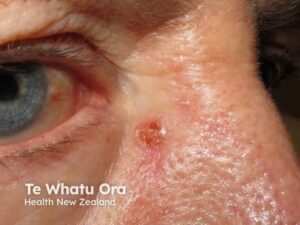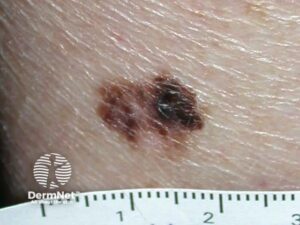
What Happens in A Mole Check: Hear from Our Patients
Skin cancer is the most common cancer, but treatable if detected early – which is where regular check-ups come in.
Not all moles are harmless, but for those that are cancerous, quick treatment yields the best results. We know this can feel a little daunting, so here are four real patient stories to show what happens in a mole check.
Sally
Sally is a local mum who came to No. 23 Skin through a friend’s recommendation after spotting a new mole on her wrist. It wasn’t painful or itchy — just something she hadn’t noticed before. Like many of our patients, she wasn’t overly worried, but decided it was worth having checked for peace of mind.
During her appointment, Dr Cherry Armstrong carried out a comprehensive mole check, carefully examining Sally’s skin from head to toe — including areas that are difficult to see yourself. The mole on her wrist stood out under dermoscopy (a magnified light used to assess moles in detail), showing subtle features that can sometimes suggest a basal cell carcinoma (BCC) — the most common form of skin cancer.
Dr Cherry recommended removing the mole there and then. The minor procedure was quick, performed under local anaesthetic, and the sample was sent to the laboratory for analysis. A few days later, the results confirmed it was indeed a superficial BCC — and, thankfully, the mole had been completely excised during that first visit.
Sally didn’t need any further treatment. Understandably relieved, she now attends six-monthly skin checks as part of her ongoing care. She often says she’s grateful she decided to book that appointment when she did — not only for catching something early, but also for the reassurance she feels knowing her skin is being properly monitored.
The cosmetic result of her mole removal healed beautifully, and she’s since returned for other aspects of her skin health.
At No. 23 Skin, we’re able to carry out mole assessments and removals safely in-clinic, or refer you back to the NHS if urgent treatment is needed and you’d prefer that route.
Because most moles are harmless — but it’s the one that isn’t that makes the check worthwhile.

Mary
When Mary moved to London, one of the first things on her to-do list was finding a dermatologist she could trust for her regular skin checks. Having grown up in Australia, she knew all too well the long-term effects of sun exposure — especially from those years in the 1970s when SPF was more of an afterthought than a daily habit… baby oil was the pre-sun skincare of choice (we’ve all been there).
After searching “mole check near me,” she found No. 23 Skin and booked an appointment online with Dr Roest for a comprehensive skin examination.
During her consultation, Dr Roest carefully examined Mary’s skin from head to toe, using dermoscopy to assess each mole and mark of pigmentation. The reassuring news was that none showed signs of concern. However, a few harmless seborrhoeic keratoses — common, raised brown patches linked to age and sun exposure — were identified. Whilst Mary could have chosen not to do anything, she felt they were unsightly and opted to have them easily treated on the day using cryotherapy, a quick freezing technique that removes them safely and comfortably.
Mary left feeling reassured, and a little lighter — knowing her skin was healthy and professionally reviewed.
As part of her ongoing skin health plan, she’s invited back each year for her annual skin check, so any future changes can be caught early.
For Mary, it’s become a simple yearly ritual — one that gives her the peace of mind to keep living her life in the sun (with SPF firmly on, of course).

Clive
Clive came to see us after noticing two moles that didn’t look quite right. He’s the kind of person who doesn’t like to wait around — and decided to take his health into his own hands. After searching for a dermatologist in London, he chose No. 23 Skin based on our reputation and patient reviews.
During his appointment, one of our dermatologists carried out a comprehensive skin examination, reviewing not just the two moles Clive was worried about, but the rest of his skin too. Both of the moles in question showed suspicious features under dermoscopy, and Dr Bhate recommended removing them for analysis.
The minor surgical procedure was performed in-clinic under local anaesthetic, and both samples were sent to the lab for confirmation. A few days later, the results showed that one mole was a basal cell carcinoma (BCC) — an early form of skin cancer. Fortunately, the cancer had been completely removed, and no further treatment was needed.
By catching it early, Clive avoided more extensive procedures and potential scarring. He’ll return in 3–6 months to review for any changes given his higher risk profile — but he leaves with peace of mind, knowing that any future changes will be detected early and managed quickly.
Example of a BCC (NB: BCC’s can vary in appearance so please consult and doctor if you have any concerns).
Emma
Emma, 36, booked her first mole check after noticing a few new freckles following a summer holiday. She wasn’t overly concerned but wanted to be thorough — the kind of proactive, health-conscious step she takes in most parts of her life.
Her appointment with one of our dermatologists Dr Sukhi Dhariwal began, as always, with a full skin examination. Every mole was inspected with dermoscopy to make sure there were no early warning signs — and happily, there weren’t. But during the consultation, Emma mentioned something else that had been bothering her: persistent flushing and small bumps around her cheeks and nose that no skincare routine seemed to calm.
After a closer look, her dermatologist diagnosed acne rosacea, a common inflammatory skin condition that can worsen with stress, heat, or alcohol — and often goes undiagnosed for years. Together, they built a simple treatment plan combining prescription topicals, gentle in-clinic laser therapy, and small lifestyle adjustments to reduce flare-ups.
Within a few weeks, Emma noticed her skin was clearer, calmer, and far less reactive. What began as a routine mole check, helped her achieve clearer skin which she wasn’t sure was treatable before the chat with the dermatologist. Her words: “I came in to tick a box — and left feeling like I finally understood my skin.”
Frank
Frank was no stranger to mole checks. Having spent much of his life outdoors — and with a property in the Caribbean — he understood the importance of regular skin monitoring. Years in the sun had given him colour, but also a healthy respect for what UV exposure can mean long-term.
During his latest full-body mole check at No. 23 Skin, our dermatologist identified a suspicious mole on his shoulder. Under dermoscopy, it showed features consistent with a possible melanoma, and whilst rare, this is the most serious form of skin cancer.
Acting quickly, our team arranged an urgent hospital referral through our consultant colleagues. Within a week, the mole was removed by wide local excision, ensuring all potentially affected tissue was taken.
Pathology confirmed that it was indeed a melanoma — but thanks to early detection and prompt treatment, it had been fully removed, and no further therapy was required. Frank remains fit and well, continuing with his regular skin checks every six months.
For him, the experience reinforced why vigilance matters: even for those used to the sun, checking regularly and acting early can make all the difference.
Example of a melanoma (NB: not all look the same so please do check with your doctor if you have any concerns).
Worried about a mole? Get it checked and removed on the same day by our industry-leading dermatologists.
Book online or call us on 02039411815 for more information.
Helen & Dr Cherry
Co-Founders
No. 23 Skin
02039411815

Please note: The information shared in this article is for general educational purposes only and should not be used as a substitute for individual medical advice, diagnosis, or treatment.
If you have any concerns about your skin or health, please seek guidance from a qualified medical professional.

